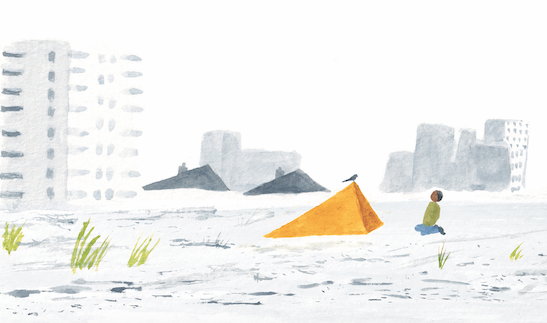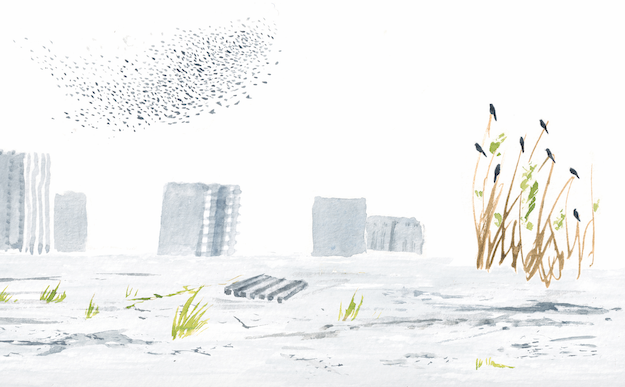Deputy editor Abigail Whyte speaks to birder David Lindo, whose childhood memories of discovering the natural world among the dumped shopping trollies in his local river have inspired a passion for urban wildlife that he wants to instil in all city kids
Illustrations by Miranda Harris
Ten years ago, David Lindo wrote his first book The Urban Birder, described by naturalist Stephen Moss as something that should be read by anyone who has ever lived in, travelled through or visited a city for it carries a vital message: “If we don’t notice the wild creatures on our doorstep, how are we going to look after those further afield?”. With a new photographic book out this year, David Lindo spoke to me via Zoom from his home in Extremadura, Spain, to reflect on his career as the Urban Birder, the power of storytelling in conservation, and the importance of cherishing what’s on your doorstep.
“I grew up in London. I had a park just down the road from me – it had a river running through it, which was basically a canal with shopping trollies and scooters chucked in. The water had a film of oil on it. It was pretty crap. On the opposite bank was undeveloped land full of rubble and weeds. That was my countryside. I used to scramble across and make camps, and I saw my first skylarks there. As a kid I thought it was an area that would never change, but it had been earmarked to be built into a massive estate. When that happened, it was my first lesson in habitat destruction. The flock of tree sparrows I’d taken for granted every winter were suddenly gone.
I’m campaigning to make London and other cities less grey, and more green and blue. Of course we need housing, but why not build estates that incorporate a lake and woodland, so that kids grow up learning to love that space and not have the compulsion to dump their crap in it?
As the Urban Birder, my message is global. There’s a whole world out there to encourage and inspire to get into birding. I want to popularise and modernise it – to make birding interesting, sexy and accessible, like Jamie Oliver did for cooking. I also want to popularise the idea that the environment, nature, the planet – it all starts on your doorstep. When you’re sitting outside having a coffee, just look up and you’ll see something – something that has a backstory that spans the planet, not just the high street.
I think there is a problem with how nature is ‘sold’ in the first place. It’s sold as something that’s in the countryside. Eighteen per cent of the British population live in rural areas, whereas 82 per cent live in cities – this needs to be more catered for in nature programmes. Audiences need to be shown more urban wildlife so they can see that cities aren’t ring-fenced from the countryside, and that wildlife isn’t just something you see in a nature reserve. That myth of nature being ‘out there’ is something I’ve been trying to dispel for my whole career.
All respect to David Attenborough. He is the don and his programmes are amazing, but every time a new series comes out, the bar is raised even higher. It’s full of spectacle and action sequences. There’s no lesson from that. And the audience thinks, ‘That’s over there, that’s nothing to do with me. My life’s here.’ I think more can be done to show people the relevance of what’s on their doorstep; how the flowerpot on their window ledge in their council estate flat is connected to the rainforest or the Congo or the Antarctic.
I’ve noticed a resistance among ethnic minorities to admit to being interested in nature. I remember taking two school groups out to show them the grounds of the BBC in Bristol. The first group was from a suburban posh school; mainly white pupils. They came along and – bam – were really into it, searching for buds and other things. The other school, an inner city one with predominantly Asian and black pupils, when they turned up it was a very different atmosphere. They were reticent, quite stand-offish, but I could tell they wanted to be involved so I really worked at it. Eventually they came round. I find that reticence interesting – I think it’s down to the fact that they feel it’s not their world because of what they see around them. All they see is white people getting involved in the countryside. No one black or Asian is doing it, or very few, if any. That’s what the issue is, and that needs to be changed. I hope that by doing what I do, I’m inspiring other ethnically diverse people to think ‘I can do that too’.
I’ve only ever received racism from a birder once. There have been other subtle incidences though, for instance, I used to go out with a white woman who was a birder. We noticed that when we went out birding together, other birders would come up to us (usually white men with beards and bellies) and they’d just be about to ask that perennial question, ‘Is there anything about?’. But they’d look at her and think ‘She’s a woman, she’s not going to know’ and then they’d look at me and think ‘He’s a black guy, he’s not going to know either,’ and then they’d walk off. We’d find it quite funny.
If we can influence lots of people in urban areas and help them realise there’s something worth protecting, then we’d have more people that can help. I’d call that the conservation army – they may not necessarily be birders or anything like that, but they’d have a sympathy, an empathy, so if an issue comes up they’d be quick to put their hands in their pockets or sign a petition because they understand it’s important. And that understanding starts from a local level, when they realise their local park needs to have wild areas, or they think, ‘Maybe I shouldn’t astroturf my lawn – maybe I need to have wild areas so my kids can see butterflies.
My favourite habitat for birding is wetlands. Anywhere where there’s a source of water, that’s where you'll find lots of birds because that’s where they need to bathe, feed and drink.
I love using storytelling to engage people with birding. For instance, for a robin, I explain how it’s a woodland dweller that only started appearing in large gardens on the edges of cities at the end of the Industrial Revolution. As pollution eased, they ventured into urban gardens, which coincided with us becoming a nation of gardeners. The robins realised that by waiting around while we dig with our pitchforks, we’d be exposing invertebrates for them. In their eyes, we’re huge pigs or deer rotavating the soil. Basically, they’ve adapted their instincts and previous behaviour to a modern scenario. It’s those sorts of things that transform birding into a story, that make the layperson think ‘wow’ and look at birds differently. That’s the power of storytelling.”



